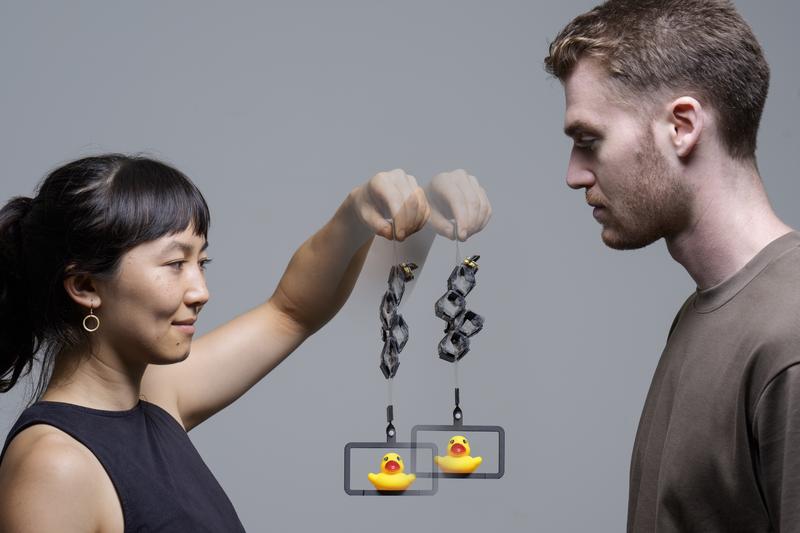Hexagonal electrohydraulic modules shape-shift into versatile robots
Embargo: Not for Release Until 2:00 pm U.S. Eastern Time Wednesday, 18 September 2024, 8pm German time.
● Scientists at MPI-IS have developed electrically driven robotic components, called HEXEL modules, which can snap together into high-speed reconfigurable robots.
● Magnets embedded along the outside of the modules allow them to electrically and mechanically connect to other modules, forming robots with diverse shapes and capabilities.
● HEXEL modules are a promising technology for use in resource-limited environments, such as on space or rescue missions, and can be used to construct versatile robots from redundant parts, altogether promoting a sustainable robot design.
Researchers at the Max Planck Institute for Intelligent Systems in Stuttgart combined soft artificial muscles with a rigid, magnetic exoskeleton to create building blocks for fast-moving reconfigurable robots.
Embargo: Not for Release Until 2:00 pm U.S. Eastern Time Wednesday, 18 September 2024, 8pm German time.
Stuttgart – Scientists at the Max-Planck-Institute for Intelligent Systems (MPI-IS) have developed hexagon-shaped robotic components, called modules, that can be snapped together LEGO-style into high-speed robots that can be rearranged for different capabilities. The team of researchers from the Robotic Materials Department at MPI-IS, led by Christoph Keplinger, integrated artificial muscles into hexagonal exoskeletons that are embedded with magnets, allowing for quick mechanical and electrical connections. The team’s work, “Hexagonal electrohydraulic modules for rapidly reconfigurable high-speed robots” will be published in Science Robotics on September 18, 2024.
Six lightweight rigid plates made from glass fiber serve as the exoskeleton of each HEXEL module. The inner joints of the hexagons are driven by hydraulically amplified self-healing electrostatic (HASEL) artificial muscles. Applying a high voltage to the module causes the muscle to activate, rotating the joints of the hexagon and changing its shape from long and narrow to wide and flat.
“Combining soft and rigid components in this way enables high strokes and high speeds. By connecting several modules, we can create new robot geometries and repurpose them for changing needs”, says Ellen Rumley, a visiting researcher from the University of Colorado Boulder. She and Zachary Yoder, who are both Ph.D. students working in the Robotic Materials Department, are co-first authors of the publication.
In a video, the team shows the many behaviors that can be created with HEXEL modules. A group of modules crawls through a narrow gap, while a single module actuates so fast that it can leap into the air. Multiple modules are connected into larger structures that produce different motions depending on how the modules are attached. For instance, the team combined several modules into a robot which rapidly rolls.
“In general, it makes a lot of sense to develop robots with reconfigurable capabilities. It’s a sustainable design option – instead of buying five different robots for five different purposes, we can build many different robots by using the same components. Robots made from reconfigurable modules could be rearranged on demand to provide more versatility than specialized systems, which could be beneficial in resource-limited environments'', Yoder concludes.
Reference:
Zachary Yoder†, Ellen H. Rumley†, Ingemar Schmidt, Philipp Rothemund, Christoph Keplinger*, Hexagonal electrohydraulic modules for rapidly reconfigurable high-speed robots. Sci. Robot. (2024). DOI:10.1126/scirobotics.adl3546
†Equal contribution
*Corresponding author
Wissenschaftlicher Ansprechpartner:
Ellen Rumley rumley@is.mpg.de
Zachary Yoder yoder@is.mpg.de
Originalpublikation:
Hexagonal electrohydraulic modules for rapidly reconfigurable high-speed robots. Sci. Robot. (2024). DOI:10.1126/scirobotics.adl3546
Weitere Informationen:
http://www.is.mpg.de/news
http://Fotos and Videos can be found here: https://www.dropbox.com/scl/fo/rz8a6nz9lakylxh8ws2l8/ABazGbtdEDxeUPnTYGjKnSg?rlkey=cu3msfequatsys1eeyo5doop3&dl=0
http://A Video will go live on Youtube at 8pm German time on 18the September 24:
https://www.youtube.com/watch?v=AQZGJlFntCE
Ähnliche Pressemitteilungen im idw



